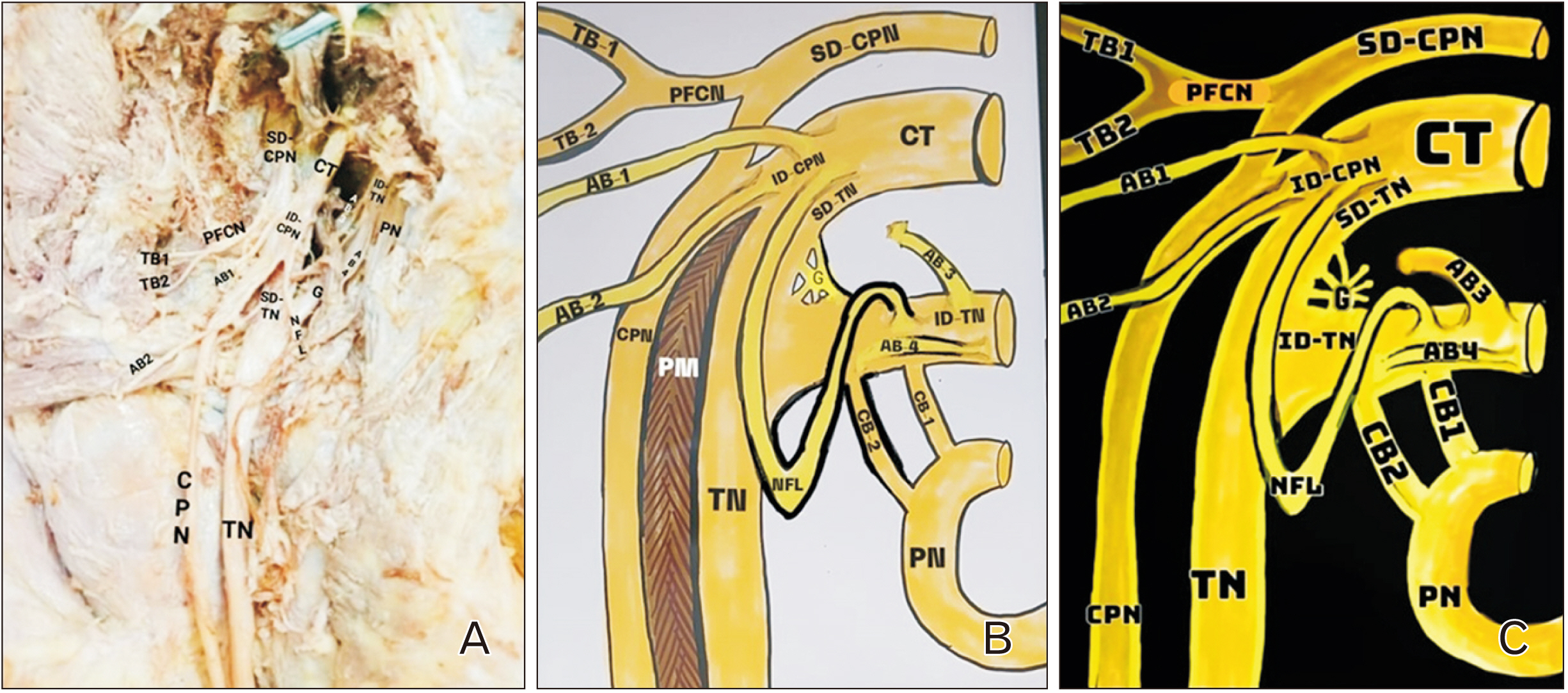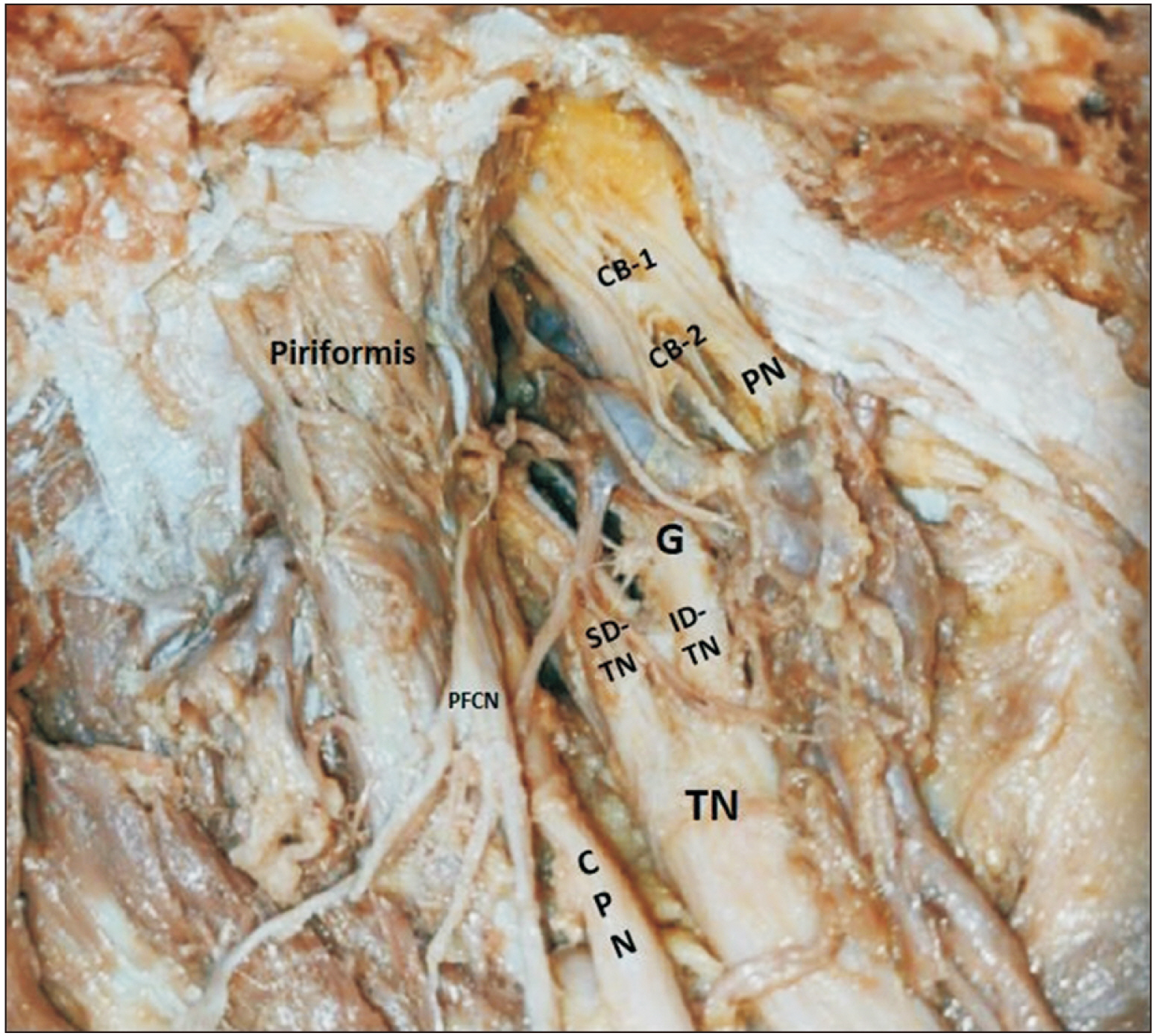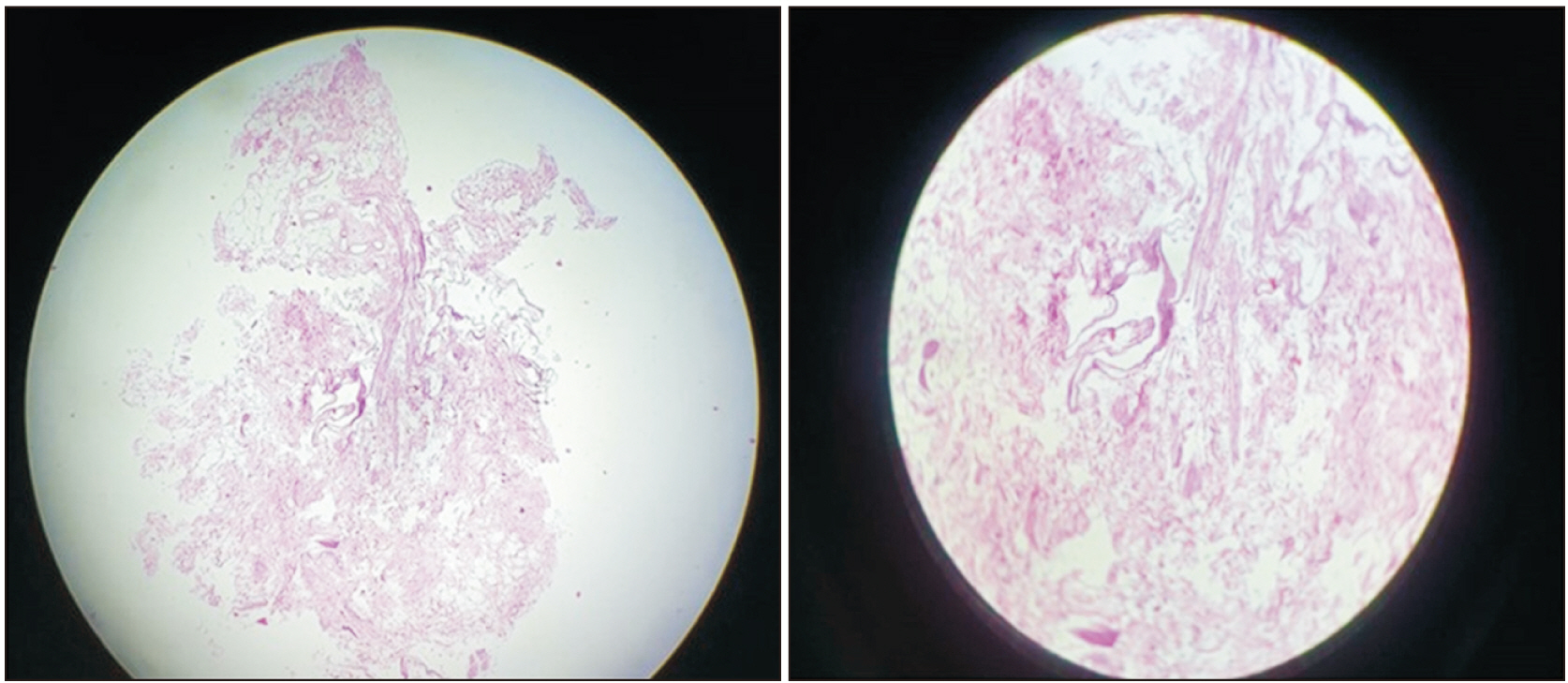Anat Cell Biol.
2024 Jun;57(2):320-323. 10.5115/acb.23.252.
An anomalous pseudoganglion associated with high division of sciatic nerve
- Affiliations
-
- 1Departments of Anatomy, AIIMS Bibingar, Bibingar, India
- 2Departments of Pathology, AIIMS Bibingar, Bibingar, India
- KMID: 2556577
- DOI: http://doi.org/10.5115/acb.23.252
Abstract
- Sciatic nerve (SN) is the thickest and longest nerve of the body. Deviations from the normal anatomical origin and level of bifurcation of SN have been frequently reported. In the present case, we are presenting a unique scenario of origin of terminal branches of the SN-tibial nerve (TN) and common peroneal nerve (CPN) in the pelvic region itself from divisions arising directly from the lumbosacral plexus. This variation was associated with origin of posterior femoral cutaneous nerve from the superior division of CPN with anomalous communicating branches between pudendal nerve and TN. The unique characteristics of the present case are the presence of ‘pseudoganglion’ found on the inferior division of TN. The present case stands out as the first of its kind to mention such pseudoganglion. Knowledge of some unusual findings like presence of pseudoganglion and intercommunications between nerves have clinical implications in anesthesiology, neurology, sports medicine, and surgery.
Keyword
Figure
Reference
-
References
1. Drake RL, Vogl AW, Mitchell AWM. Gray's anatomy for students. 4th ed. Elsevier;2020. p. 571–2.2. Jee K, Singh AK, Kumar N, Dutta S. 2015; Anomalous formation and branching pattern of the sciatic and pudendal nerves. Eur J Anat. 19:391–5.3. Ranjan R, Chanda C, Kushwaha R, Nag AR. 2022; Anatomical study of the variants of the extrapelvic part of the pudendal nerve. Cureus. 14:e28281. DOI: 10.7759/cureus.28281. PMID: 36158338. PMCID: PMC9492552.4. Tunali S, Cankara N, Albay S. 2011; A rare case of communicating branch between the posterior femoral cutaneous and the sciatic nerves. Rom J Morphol Embryol. 52:203–5. PMID: 21424057.5. Kotian SR, D'Souza AS, Shamshudheen S, Sangeetha C, Sumalatha S. 2014; Multiple anomalous variations in the gluteal region. Online J Health Allied Sci. 13:5.6. Nayak SB, George BM, Mishra S. 2014; A sciatic nerve with three roots and its perforation by the enlarged ischiadic artery. Anat Sci Int. 89:118–21. DOI: 10.1007/s12565-013-0198-6. PMID: 23959929.
Article7. Berihu BA, Debeb YG. 2015; Anatomical variation in bifurcation and trifurcations of sciatic nerve and its clinical implications: in selected university in Ethiopia. BMC Res Notes. 8:633. DOI: 10.1186/s13104-015-1626-6. PMID: 26526618. PMCID: PMC4630888.
Article8. Tomaszewski KA, Graves MJ, Henry BM, Popieluszko P, Roy J, Pękala PA, Hsieh WC, Vikse J, Walocha JA. 2016; Surgical anatomy of the sciatic nerve: a meta-analysis. J Orthop Res. 34:1820–7. DOI: 10.1002/jor.23186. PMID: 26856540.
Article9. Beaton LE, Anson BJ. 1937; The relation of the sciatic nerve and of its subdivisions to the piriformis muscle. Anat Rec. 70:1–5. DOI: 10.1002/ar.1090700102.
Article10. Güvençer M, Iyem C, Akyer P, Tetik S, Naderi S. 2009; Variations in the high division of the sciatic nerve and relationship between the sciatic nerve and the piriformis. Turk Neurosurg. 19:139–44. PMID: 19431123.11. Pais D, Casal D, Bettencourt Pires MA, Furtado A, Bilhim T, Angélica-Almeida M, Goyri-O'Neill J. 2013; Sciatic nerve high division: two different anatomical variants. Acta Med Port. 26:208–11. PMID: 23815833.12. Huang B, Decater T, Iwanaga J, Dumont AS, Tubbs RS. 2020; Reunification of a split sciatic nerve. Anat Cell Biol. 53:369–71. DOI: 10.5115/acb.20.096. PMID: 32879057. PMCID: PMC7527125.
Article13. Russa AD, Fabian FM. 2017; A unique quadrifurcation of the sciatic nerve in the lower leg. Anat J Afr. 6:919–23. DOI: 10.4314/aja.v6i2.160461.
Article14. Satheesha Nayak B. 2006; An unusual case of trifurcation of the sciatic nerve. Neuroanatomy. 5:6–7.15. Agarwal P, Sharma D, Wankhede S, Jain PC, Agrawal NL. 2019; Sciatic nerve to pudendal nerve transfer: anatomical feasibility for a new proposed technique. Indian J Plast Surg. 52:222–5. DOI: 10.1055/s-0039-1688513. PMID: 31602139. PMCID: PMC6785340.
Article
- Full Text Links
- Actions
-
Cited
- CITED
-
- Close
- Share
- Similar articles
-
- Combined Femoral and Sciatic Nerve Palsy Associated with Acetabular Fracture and Dislocation: A Case Report
- Sciatic Nerve Compression due to Ganglion
- Histological and electrophysiological study on nerve regenerationfollowing nerve repair in rat sciatic nerve
- The Electrodiagnostic Findings of Sciatic Nerve Injury according to the Locations and Etiologies
- Sural Nerve Graftafter Resection of a Schwannoma in the Sciatic Nerve : A Case Report




